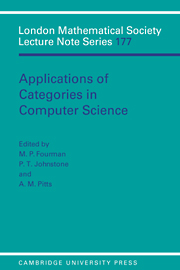 Applications of Categories in Computer Science
Applications of Categories in Computer Science Book contents
- Frontmatter
- Contents
- Preface
- Miscellaneous Frontmatter
- Computational comonads and intensional semantics
- Weakly distributive categories
- Sequentiality and full abstraction
- Remarks on algebraically compact categories
- Dinaturality for free
- Simply typed and untyped lambda calculus revisited
- Modelling reduction in confluent categories
- On clubs and data-type constructors
- Penrose diagrams and 2-dimensional rewriting
- Strong monads, algebras and fixed points
- Semantics of local variables
- Using fibrations to understand subtypes
- Reasoning about sequential functions via logical relations
- I-categories and duality
- Geometric theories and databases
- Partial products, bagdomains and hyperlocal toposes
Partial products, bagdomains and hyperlocal toposes
Published online by Cambridge University Press: 24 September 2009
- Frontmatter
- Contents
- Preface
- Miscellaneous Frontmatter
- Computational comonads and intensional semantics
- Weakly distributive categories
- Sequentiality and full abstraction
- Remarks on algebraically compact categories
- Dinaturality for free
- Simply typed and untyped lambda calculus revisited
- Modelling reduction in confluent categories
- On clubs and data-type constructors
- Penrose diagrams and 2-dimensional rewriting
- Strong monads, algebras and fixed points
- Semantics of local variables
- Using fibrations to understand subtypes
- Reasoning about sequential functions via logical relations
- I-categories and duality
- Geometric theories and databases
- Partial products, bagdomains and hyperlocal toposes
Summary
Introduction
In a recent paper, Steven Vickers introduced a ‘generalized powerdomain’ construction, which he called the (lower) bagdomain, for algebraic posets, and argued that it provides a more realistic model than the powerdomain for the theory of databases (cf. Gunter). The basic idea is that our ‘partial information’ about a possible database should be specified not by a set of partial records of individuals, but by an indexed family (or, in Vickers' terminology, a bag) of such records: we do not want to be forced to identify two individuals in our database merely because the information that we have about them so far happens to be identical (even though we may, at some later stage, obtain the information that they are in fact the same individual).
There is an obvious problem with this notion. Even if the domain from which we start has only one point, the points of its bagdomain should correspond to arbitrary sets, and the ‘refinement ordering’ on them to arbitrary functions between sets, so that the bagdomain clearly cannot be a space (or even a locale) as usually understood. However, topos-theorists have long known how to handle ‘the space of all sets’ as a topos (the object classifier, cf. Johnstone and Wraith, pp. 175–6), and this is what Vickers constructs: that is, given an algebraic poset D, he constructs a topos BL(D) whose points are bags of points of D (and in the case when D has just one point, BL(D) is indeed the object classifier).
- Type
- Chapter
- Information
- Applications of Categories in Computer ScienceProceedings of the London Mathematical Society Symposium, Durham 1991, pp. 315 - 339Publisher: Cambridge University PressPrint publication year: 1992
- 4
- Cited by


